7 top-rated sleeping bags for your next trip
Select independently determines what we cover and recommend. When you buy through our links, we may earn a commission. Learn more.
There’s no such thing as the perfect sleeping bag for everyone and every situation. However, the right sleeping bag can be the difference between a peaceful slumber and a restless, uncomfortable and unbearably chilly night.
SKIP AHEAD Our top picks | How we picked the best sleeping bags | Top-rated sleeping bags | What to keep in mind when shopping for a sleeping bag
But how do you choose the right sleeping bag? Your decision should come down to the type of bag you want and the environment you’ll be sleeping in, says Tory Jon, founder of Camper FAQs, a site that provides helpful tips to campers and RV owners. To help you decide, we talked with camping experts on what to look for while you shop and picked highly rated options that met their requirements.
Our top picks
Best overall: Farland Sleeping Bag
Best budget: MalloMe Sleeping Bag
Best splurge: The North Face Chrysalis 20 Sleeping Bag
Best down sleeping bag: Hyke & Byke Eolus Hiking & Biking Sleeping Bag
How we picked top-rated sleeping bags
When shopping for a sleeping bag, experts we spoke with said there are three things to keep in mind. They are:
Temperature rating: “This is arguably the most important factor to consider,” says Jon. “The temperature rating tells you the lowest temperature at which the bag is meant to keep the average sleeper warm.” So, a 32 F bag should keep you comfortable down to 32 F. This rating can generally be found on the bag’s label. Jon suggests looking for a three-season bag, which can be used in spring, summer and fall because they are the most versatile.
Fill: You have your choice between two materials: duck or goose down or synthetic insulation. “Down is lightweight, compressible and durable but underperforms when wet,” says Jon. “Synthetic insulation is bulkier but retains warmth when damp and is usually cheaper.” Backpackers find that a sleeping bag with down fill is easier to carry, but if you plan to sleep without the protection of a tent, synthetic may be better in case it gets wet.
Added features: Look for water resistance or a hood to help keep you warm and comfortable, says Jon. Zippered pockets are great to store items you want to keep close while you sleep. A bag constructed with baffles (horizontal or vertical seams that run the length of the bag) will ensure the fill stays evenly spread out — all the bags we chose have baffles.
Top-rated sleeping bags
MalloMe Sleeping Bag
Even in the thick of summer, campsites can get chilly at night. A sleeping bag with a hood, like this one, can keep you warm. “If you are sleeping in colder conditions, you’ll want a hood — they provide added warmth and prevent heat from escaping,” says Kristen Bor, an avid camper and founder of Bearfoot Theory, a blog that provides camping resources and tips. In between uses, roll it up tightly into the 16 by 9-inch compression stuff sack it comes with and stash it in your backpack or, if you are car camping, your trunk. This bag has a 4.8-star average from over 7,800 reviews on Amazon.
Temperature rating: 40 F | Dimensions: 86.6 x 29.5 inches | Fill: Synthetic | Water-resistant: Yes
MalloMe Sleeping Bag
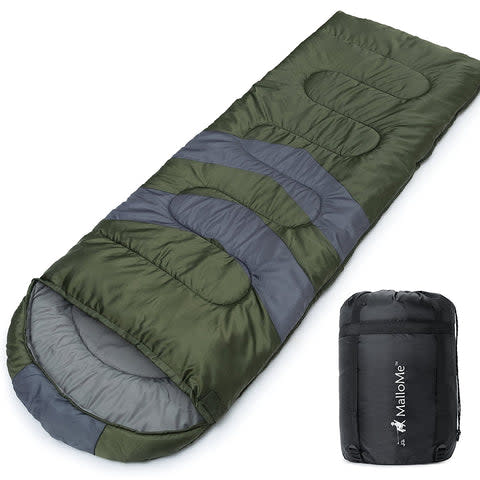
Farland Sleeping Bag
This sleeping bag is filled with synthetic fibers and the outer shell is made of water-resistant nylon, a combo Jon says can prevent your bag from absorbing moisture and getting damp if your bag will be laying directly on the ground. Traveling with a spouse or partner? You can zip two of these together to create a double bag big enough for two, according to the brand. This option has a 4.4-star average from over 4,500 reviews on Amazon.
Temperature rating: 20°F | Dimensions: 86.5 x 29.5 inches | Fill: Synthetic | Water-resistant: Yes
Farland Sleeping Bag
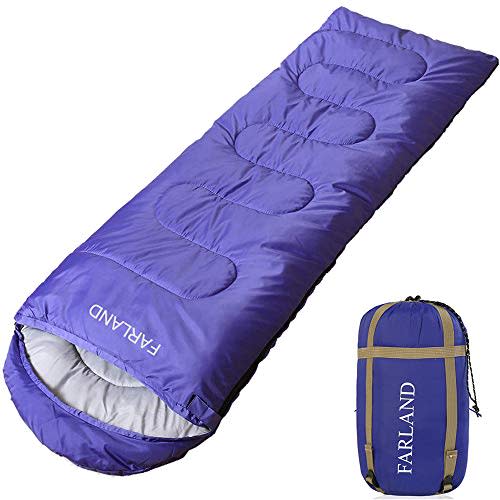
Farland Sleeping Bag $ at Amazon
Hyke & Byke Eolus Hiking & Biking Sleeping Bag
If you’ll be camping in really cold weather, Jon suggests a mummy-style bag with a hood like this one to keep you toasty. This silhouette is wider at the top and then narrows towards the footbed to provide a close-to-the-body fit that traps heat. To help you get the right fit for your frame, it comes in short, medium and long lengths. This bag has a 4.5-star average from over 1,000 reviews on Amazon.
Temperature rating: 0°F | Dimensions: 72 x 26 inches (short), 78 x 28 inches (medium), 87 x 32 inches (long) | Fill: Down | Water-resistant: Yes
Hyke & Byke Hiking & Backpacking Sleeping Bag
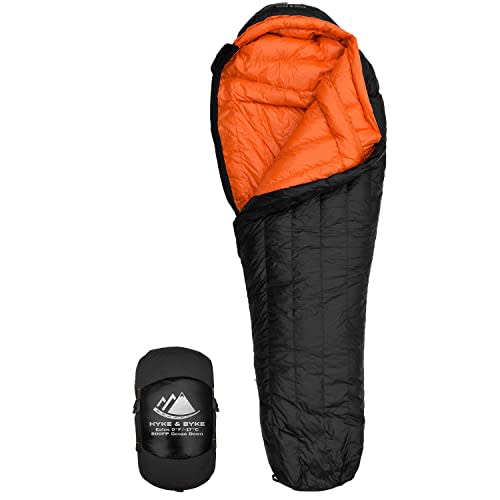
Hyke & Byke Hiking & Backpacking Sleeping Bag $ at Amazon
Coleman Biscayne Big & Tall Warm-Weather Sleeping Bag
If you are tall or living in a larger body, this big and tall style from Coleman is worth considering. It’s made for people who are up to 6 feet, 4 inches tall, and, at 39 inches wide, it is roomier than other bags on this list. Just know this bag is not intended for super cold weather — it’s best for temperatures 40°F and up. This synthetic sleeping bag has a 4.7-star average from over 2,500 reviews on Amazon.
Temperature rating: 40°F | Dimensions: 81 x 39 inches | Fill: Synthetic | Water-resistant: Yes
Coleman Biscayne Big & Tall Warm-Weather Sleeping Bag
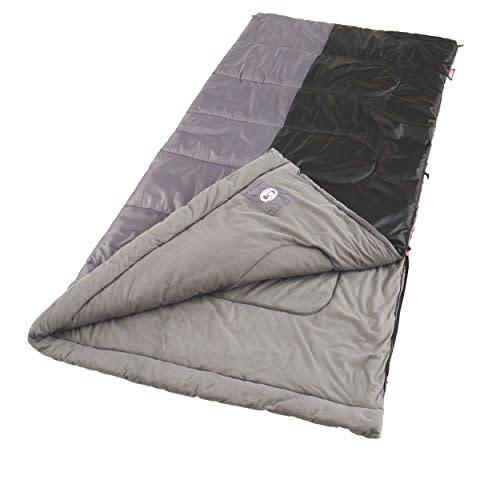
Coleman Biscayne Big & Tall Warm-Weather Sleeping Bag $ at Amazon
Coleman Biscayne Big & Tall Warm-Weather Sleeping Bag $ at Coleman
Sea to Summit Traveller Sleeping Bag/Blanket
“Weight is very important if you plan to take your sleeping bag backpacking where every ounce matters,” says Bor. This bag is under two pounds and rolls up into a compression sack that is smaller than a 25-ounce water bottle, according to the brand — factors our experts said make for a good backpacking option. In terms of temperature rating, you can choose from a 30°F or 50°F model, as well as a regular or long length. It also comes with drawstrings at the shoulders and feet. Tighten them for warmth or leave them loose to allow more airflow, says the brand.
Temperature rating: 30°F or 50°F | Dimensions: 81 x 29 inches (regular), 87 x 33 inches (long) | Fill: Down | Water-resistant: Yes
Sea to Summit Traveller Sleeping Bag/Blanket
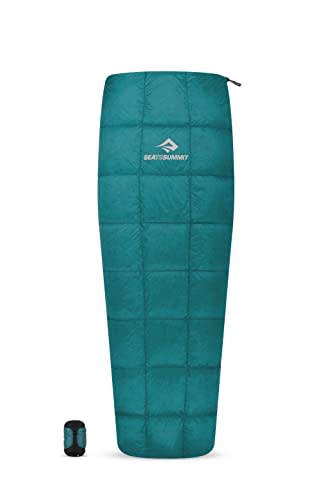
Sea to Summit Traveller Sleeping Bag/Blanket $ at Amazon
Sea to Summit Traveller Sleeping Bag/Blanket $ at Sea to Summit
Kelty Pack Galactic 30 Sleeping Bag
“The most versatile sleeping bag will be one rated 20°F to 30°F,” says Bor. “If it's warmer at night, you can sleep in light clothing with the bag unzipped. If it's colder, you can sleep in warm base layers and add a sleeping bag liner or a blanket.” This option from Ketly has a temperature rating of 30°F. And to Bor’s point about unzipping your bag, if it’s warmer, it has two-way zippers, so you can open the footbed to give your feet some air while keeping your upper body zipped in if you’d like. It also has a drawcord at the top of the bag, so you can tighten it around your shoulders to maximize body heat if it is cold out, according to the brand.
Temperature rating: 30°F | Dimensions: 75 x 33 inches | Fill: Down | Water-resistant: Yes
Kelty Pack Galactic 30 Sleeping Bag
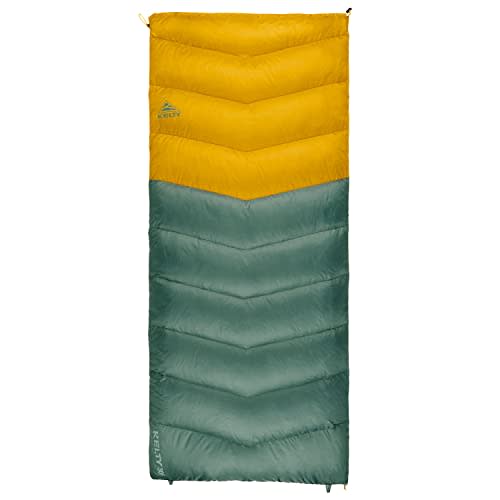
Kelty Pack Galactic 30 Sleeping Bag $ at Amazon
Kelty Pack Galactic 30 Sleeping Bag $ at DICK'S Sporting Goods
Kelty Pack Galactic 30 Sleeping Bag $ at REI
The North Face Chrysalis 20 Sleeping Bag
According to our experts, an ultra lightweight bag is only necessary if you’ll be carrying your sleeping bag on your back for a long period of time (like on a backpacking trip). “In this case, a lightweight, packable sleeping bag will be easier to transport,” says Bor. “Bags that are lighter and pack down really small tend to be more expensive.” This option for The North Face weighs in at one pound, nine ounces — our experts agreed anything under two pounds counts as lightweight. It comes with a compression bag that packs it down to the size of a 32-ounce water bottle, so it can assist you if you are trying to engage in ultra-lightweight backpacking, according to the brand. It also has a hood with a cinch cord, so you can bring it close to your head for added warmth.
Temperature rating: 20°F | Dimensions: 83 x 32 inches | Fill: Down | Water-resistant: Yes
The North Face Chrysalis 20 Sleeping Bag

The North Face Chrysalis 20 Sleeping Bag $ at DICK'S Sporting Goods
The North Face Chrysalis 20 Sleeping Bag $ at The North Face
What to keep in mind when shopping for a sleeping bag
Every situation might call for a different sleeping bag, says Jon. It all depends on your location, the weather and your body.
Focus on staying warm…or cool
As Jon mentioned above, temperature rating is the most important thing to keep in mind when shopping for a sleeping bag. If you don’t consider this, you may get too cold or too hot while you sleep. “If you plan to camp in cold weather, look for something with a lower temperature rating,” says Jon. If it is warmer, a higher temperature rating should work.
One number you don’t need to worry as much about is the fill weight (also called fill power). This is often listed on sleeping bags, but our experts agreed that the temperature rating is far more accurate. “Fill weight tells you the weight of the insulation in the sleeping bag,” says Bor. “In general, the higher the fill weight, the warmer the bag, but the temperature rating of a sleeping bag is a much better indicator of this.”
If you’ll be in lower climates or you get cold easily, you may also want to consider a sleeping bag with a hood. “Hooded sleeping bags, which encapsulate your head, are generally better suited for colder environments as they help retain heat that would otherwise be lost from the head,” says Jon. “These sleeping bags often also include a ‘draft collar’ to insulate the neck, preventing warm air from escaping and cold air from intruding.” Jon points out that, conversely, bags that stop at the shoulders are typically designed for warmer climates, offering better ventilation and reducing the risk of overheating.
The shape of your sleeping bag can also make a difference when it comes to keeping your cool or warm. Sleeping bags come in two shapes: An envelope shape is rectangular, while a mummy shape tapers from the shoulders to the feet. The former tends to be more spacious and cooler, as there’s more room for airflow to move around your body. “Mummy sleeping bags fit close to the body and are efficient at trapping the warmth your body naturally creates,” says Bor.
Pay attention to the dimensions
If a sleeping bag is too small, you may have a hard time staying warm because you won’t fully be able to wrap yourself in it. If it’s too big, it could allow for too much airflow and you may find that you get cold. “Sleeping bags come in different lengths and widths, so consider your height, weight, and comfort preference,” says Jon.
Many bags come in short, regular and long lengths or will tell you the maximum suggested height. In terms of width, envelope-shaped bags tend to be wider, whereas mummy bags are more narrow. There are also big and tall bags (like the one on our list from Coleman) that are specifically made for larger bodies.
Keep in mind how far you’ll have to carry it
There are all kinds of scenarios that call for a sleeping bag. If you’re driving up to a campsite and setting up your tent nearby, you won’t have to carry your gear far. But if you plan on backpacking and hiking a long way to where you’ll be sleeping, you will want to think about the size and weight of the bag you buy. “When backpacking, you'll need a lightweight bag that compresses well,” says Jon.
Our experts agreed that any bag under two pounds is considered lightweight. In terms of compression, most sleeping bags come with either cords that allow you to roll them up and keep them secure or compression bags you can stuff them in. Some bags are even the size of a small water bottle, allowing you to tightly pack your sleeping bag and fit it in a backpack.
Meet our experts
At Select, we work with experts who have specialized knowledge and authority based on relevant training and/or experience. We also take steps to ensure all expert advice and recommendations are made independently and without undisclosed financial conflicts of interest.
Tory Jon is the founder of Camper FAQs, a website that provides camping tips
Kristen Bor is an avid camper and founder of Bearfoot Theory, a blog that provides camping resources and tips
Why trust Select?
Bethany Heitman is a contributor at NBC Select and a journalist who regularly covers topics like beauty, home and lifestyle. For this story, she interviewed two experts to gather their guidance on what to look for when shopping for a sleeping bag
Catch up on Select's in-depth coverage of personal finance, tech and tools, wellness and more, and follow us on Facebook, Instagram, Twitter and TikTok to stay up to date.
